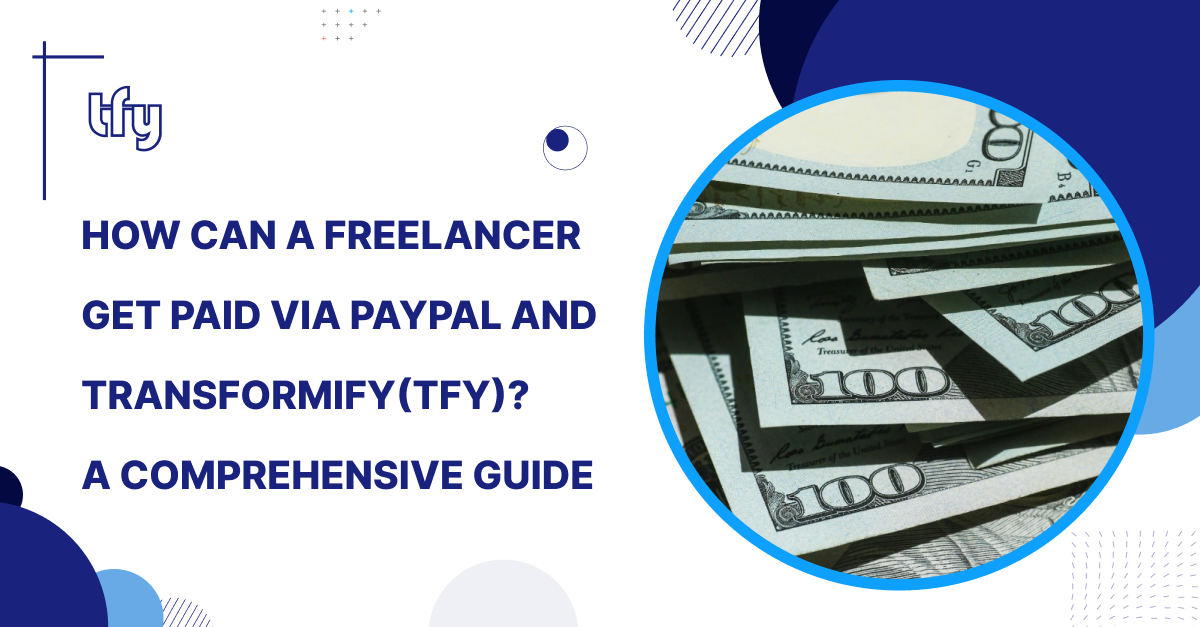
PayPal is one of the leading online payment providers that facilitates digital payments between individuals and businesses. As of 2024, it supports over 400+ million active accounts across 200 markets worldwide, underscoring its vast reach and reliability. PayPal provides a user-friendly platform, robust security measures, and additional features such as invoicing and integration with e-commerce and contractor management platforms.It comes as no surprise that Transformify (TFY), a leading workforce management system, offers an integration with PayPal to facilitate cross-border payments to freelancers and independent contractors.
You are a Freelancer Using Transformify(TFY). Here’s How You Can Set PayPal as Your Default Payment Method:
- Login to your Transformify (TFY) member account - Link
- Navigate to Payments/ Payment details
- Select PayPal and click ‘’Edit Payment Details’’
- Fill-in the email address or phone number associated with your PayPal account. Please note that it may not be the same as the email address associated with your Transformify (TFY) account. Example: Your PayPal account is associated with johndoe@gmail.com, while your Transformify (TFY) account is associated with john_doe@yahoo.com. The email address you need to fill in is the one associated with your PayPal account - eg. johndoe@gmail.com
How Does PayPal Work?
PayPal acts as an intermediary, making it possible for users to send money, receive payments, and transfer money securely online. It’s particularly beneficial for freelancers who deal with multiple clients from various geographical locations, providing a streamlined solution for international transactions. PayPal allows freelancers to accept payments securely and efficiently, making it a preferred choice for many.
Imagine you’re a freelancer who just completed a project for a client in another country. You issue an invoice through PayPal, which acts not just as a payment receiver but as a mediator that ensures the security of your funds. When you complete a project for a client halfway around the world, PayPal simplifies the payment process. Choosing the right payment method is crucial for freelancers to ensure timely compensation and adapt to their clients' preferences. By facilitating over $1.3 trillion in transactions in 2023 alone, according to PayPal’s corporate announcements, the platform underscores its role as a vital tool in global commerce. Here’s how it operates:
- Sending an Invoice: As a freelancer, you can generate and send a detailed invoice directly through PayPal. This invoice can include your payment terms and a breakdown of services provided.
- Receiving Payments: Once your client makes a payment, PayPal immediately notifies you and credits your account. The funds are available either to be used directly from your PayPal account or to be withdrawn to your linked bank account.
- Security Measures: PayPal employs robust encryption methods and fraud detection techniques to protect every transaction. This ensures that your funds are secure, whether you’re receiving small payments from individuals or large sums from businesses.
Types of PayPal Accounts
Choosing the right type of PayPal account is essential. A personal account might suffice for small one-off jobs, but a business account offers advanced features that are vital for managing multiple clients or larger projects, providing necessary tools like payment tracking and detailed financial reports.
Personal Accounts
Best suited for individuals who engage in primarily small-scale transactions. This type of account is ideal if you’re just starting out or if your transactions are mostly domestic. It’s simple to set up and manage, allowing you to send and receive money, and make online purchases securely.
Business Accounts
Tailored for freelancers, entrepreneurs, and companies who manage a larger volume of transactions or operate on a global scale. A business account comes with advanced features that are indispensable for professional use. These include the ability to set up payment solutions for websites, access to comprehensive financial tracking and reporting tools, and the capacity to handle multiple currencies and payment methods. This is crucial for managing freelancer payments efficiently. Perhaps most importantly, it offers higher transaction limits and the option for multiple team members to access the account, which is vital for scaling operations.
Each type of account comes with its own set of fees and limitations, so understanding the differences can help you choose the one that best suits your business model and growth plans.
Setting Up Your PayPal Account
First, you need to set up a PayPal account. You can choose between a Personal account and a Business account, depending on your needs. For freelancers, a Business account might be preferable due to its ability to handle larger transaction volumes and access to more detailed accounting software integration.
- Go to PayPal's website and click on Sign Up.
- Choose the account type: Personal or Business.
- Enter your personal details, including your name, address, and email address.
- Verify your email address to activate your account.
Linking Your Bank Account
To receive money, your PayPal account needs to be linked to your bank account. Linking bank accounts to PayPal is crucial for secure transactions, enabling seamless money transfers and online purchases. This process allows you to transfer funds from PayPal directly into your bank.
- Log in to your PayPal account.
- Navigate to Add card or bank.
- Click on Link a bank account. Users can connect whichever bank accounts they choose for added flexibility.
- Enter your bank account details and confirm.
Receiving Freelancer Payments
As a freelancer, you can receive payments in several ways through PayPal, including payment requests, invoices, or direct deposits from clients. PayPal helps freelancers accept payment securely by allowing them to create and send invoices efficiently.
- To request money, go to the Send and Request section.
- Enter the recipient details or your client’s email address.
- Specify the amount and currency. According to recent statistics, PayPal supports money transactions in over 25 currencies, facilitating international transactions efficiently.
- Optionally, add a note explaining the payment request and then send it. Efficient freelancer payments are crucial for maintaining good relationships with contractors and ensuring prompt service delivery.
Payment Process
When a client sends payments, PayPal will notify you via an email message. The funds will appear in your PayPal balance. You can keep the money in your PayPal account for online purchases or transfer money to your linked bank account. Bank transfers are a reliable method for freelancers to receive payments from clients, offering lower transaction fees and a straightforward process.
- To transfer money, go to your PayPal balance.
- Click on Transfer to your bank.
- Choose the amount and hit Next to transfer to your bank account.
Fees and Considerations
While receiving payments through PayPal is efficient, it comes with certain fees. For instance, PayPal charges a fee for each transaction, usually 2.9% + $0.30 per transaction within the US. International transactions may attract higher fees due to exchange rates and cross-border charges. Managing international payments efficiently is crucial to minimize these fees for global transactions.
Advantages and Drawbacks
Advantages: Quick setup, immediate payments, wide acceptance across clients, and robust security measures. PayPal also allows freelancers to accept credit cards, highlighting the speed and convenience of this payment method.
Drawbacks: Transaction fees, potential for account holds, and currency conversion fees.
To sum up, PayPal is still a powerful resource for independent contractors looking for an effective way to handle payments all around the world. It has some benefits, like speed, security, and convenience, but it also has some disadvantages. For any freelancer, the fees, possibility of account holds, and currency conversion expenses are important factors. Each person must compare these aspects to their unique financial procedures and commercial requirements.
In the end, PayPal’s powerful platform can greatly improve a freelancer’s capacity to work internationally as long as they carefully consider its terms of service and fee schedule. Understanding both the advantages and the limitations is key to making the most out of PayPal’s offerings for your freelance business.



